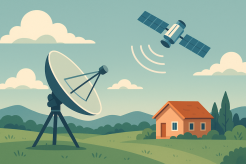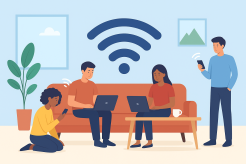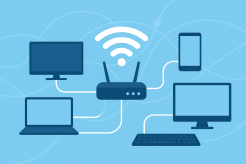What to Do If Your Local Internet Provider Keeps Buffering

Few things are more frustrating than sitting down to stream your favorite show, attend an online class, or hop on a video call—only to have your internet start buffering every few seconds. That spinning circle of doom can test anyone’s patience, especially if it happens often.
If your local internet provider keeps buffering, don’t worry—you’re not alone, and there are ways to fix it. Whether you’re on Wi-Fi, mobile data, or wired broadband, buffering usually points to a few common issues: limited bandwidth, signal interference, outdated equipment, or provider-side congestion.
In this guide, we’ll help you understand why it’s happening and walk you through practical steps to fix it (and know when it’s time to switch providers).
🎬 What Exactly Is Buffering?
Before we jump into the fixes, it helps to understand what buffering really means.
Buffering happens when your internet connection can’t deliver data fast enough to keep up with what you’re doing—whether that’s watching a video, gaming online, or loading a webpage.
Your device pauses playback while it “buffers,” or temporarily stores, more data so it can continue smoothly. The slower your internet or the higher your usage, the more buffering you’ll notice.
🚦 Common Causes of Buffering from Local Internet Providers
Let’s start by identifying what might be slowing your connection. Here are the most common culprits:
1. Network Congestion
If your neighborhood uses the same internet provider, you might be sharing bandwidth with dozens (or hundreds) of nearby users. When everyone’s streaming or gaming at once—especially in the evenings—your speed can drop.
2. Outdated Modem or Router
Old equipment often can’t handle modern data speeds or Wi-Fi protocols. If your router is over 3–4 years old, it might be time for an upgrade.
3. Weak Wi-Fi Signal
The further you are from your router, the weaker your Wi-Fi becomes. Thick walls, floors, and even microwaves can interfere with signal strength.
4. Too Many Connected Devices
If multiple people in your home are streaming, downloading, or gaming simultaneously, your bandwidth gets divided among all devices.
5. Low-Speed Internet Plan
Sometimes, the problem isn’t technical—it’s simply that your plan doesn’t provide enough speed for your household’s needs.
6. ISP Throttling
Some local internet providers intentionally slow (or “throttle”) speeds after you exceed certain data limits, especially during peak hours.
🧭 Step-by-Step: How to Fix Buffering Problems
Now that you know the possible causes, here’s what to do to stop the buffering madness.
✅ Step 1: Run an Internet Speed Test
Start by checking your actual internet speed using out speed test calculator.
Compare your results with what your provider promises.
- Download speed should be at least 25 Mbps for HD streaming and 100 Mbps or higher for multiple users.
- Upload speed matters too, especially for video calls and live streaming.
- Ping (latency) under 50 ms is ideal for smooth performance.
If your speeds are consistently lower than your plan’s advertised rate, it’s time to talk to your provider.
✅ Step 2: Restart Your Modem and Router
This might sound cliché, but rebooting your modem and router clears cached data and resets the connection with your provider’s network.
Simply unplug both devices for 30 seconds, then plug them back in.
Pro tip: Set a reminder to restart your router once a week. It can prevent small glitches from building up.
✅ Step 3: Move Your Router (or Boost Your Signal)
If your Wi-Fi signal drops in certain areas of your home, try moving your router to a more central, elevated location—away from walls, floors, and electronic devices.
If that’s not possible, consider:
- Installing a Wi-Fi extender or mesh system
- Upgrading to a dual-band or tri-band router
- Connecting devices directly with Ethernet cables for maximum stability
✅ Step 4: Limit Devices and Background Apps
Streaming on one device while others are downloading files, updating games, or syncing cloud data can quickly eat up bandwidth.
Pause large downloads or updates while you’re watching or working online. You can also schedule updates to run overnight.
If you’re using a shared connection, try using your router’s admin settings or mobile app to prioritize bandwidth for specific activities (like streaming or video calls).
✅ Step 5: Check for Data Caps or Throttling
Many local ISPs advertise “unlimited” internet—but that often comes with fine print. After using a certain amount of data (say, 1TB), they may slow your connection to reduce network strain.
Check your provider’s fair use policy or log in to your account to monitor your data usage. If you suspect throttling:
- Run multiple speed tests at different times of day.
- If speeds drop during peak hours but recover later, throttling may be the issue.
If that’s the case, contact your provider—or consider switching to one with truly unlimited data.
✅ Step 6: Update Your Router Firmware
Your router is like a mini-computer that occasionally needs updates to improve performance and security.
Check your router’s brand website or mobile app for available firmware updates and install them regularly.
Outdated firmware can cause connection drops, slower speeds, and compatibility issues with newer devices.
✅ Step 7: Use a Wired Connection
If you’re working from home or gaming, a wired Ethernet connection is still the gold standard.
It’s faster, more stable, and immune to Wi-Fi interference. Plug your device directly into the router whenever possible.
Learn more: Wi-Fi vs. Ethernet: Which Internet Connection Should You Choose?
✅ Step 8: Call Your Provider
If you’ve tried everything and buffering continues, contact your internet provider’s support team. Be specific about:
- The times buffering happens
- The devices affected
- Your recent speed test results
Sometimes, the issue is with their network, not your setup. They can check for line noise, signal degradation, or equipment malfunctions.
You can also ask them to send a technician to inspect your connection or replace outdated hardware.
🔄 When It’s Time to Change Providers
If you’ve been dealing with constant buffering for months and your provider hasn’t improved the service, it might be time to move on.
Before switching, do a quick local comparison:
- Check coverage maps to see which providers serve your area.
- Compare plans using “unlimited” data options and higher-speed tiers.
- Read customer reviews to see which ISPs are most reliable near you.
If fiber internet is available in your area, that’s usually the best long-term solution. Fiber connections deliver symmetrical upload and download speeds and are far less prone to congestion than cable or DSL.
💡 Pro Tip: Use a Secondary Internet Option
If you rely on a stable connection for work or streaming, consider keeping a backup internet source.
Options include:
- A mobile hotspot for emergencies
- A 5G home internet plan
- Satellite internet for rural areas
That way, if your main connection drops, you can switch over instantly without major downtime.
🧩 Final Thoughts
Buffering doesn’t have to ruin your online experience. In most cases, it’s caused by small issues you can fix yourself—like router placement, outdated equipment, or temporary congestion.
But if your local internet provider keeps buffering despite your best efforts, don’t settle. There are always better, faster, and more reliable options nearby.
Take time to test, compare, and upgrade where needed. A smooth, lag-free connection isn’t a luxury anymore—it’s a must-have for work, play, and everything in between.
Related Posts

Fri, Dec 5, 2025 12:20 PM
TechnologyWhy You Need a VPN Today (and How It Protects You Online)
Learn how VPNs protect your data, block tracking, and secure your connection across every device.

Thu, Dec 4, 2025 3:30 AM
Internet BundlesBest Fiber Internet Providers in the US : Fast, Reliable, and Worth It
Discover the top fiber internet providers in the US, their speeds, pricing, and customer satisfaction ratings. Find the best plan for fast, reliable, and uninterrupted internet.

Thu, Dec 4, 2025 3:17 AM
Internet Bundles cheap internet dealsHughesnet Satellite Internet Review: Plans, Pricing, Speed
Get an in-depth Hughesnet Satellite Internet review covering plans, pricing, speed, and performance. Learn whether Hughesnet is the right choice for rural or remote households

Wed, Dec 3, 2025 2:36 AM
Internet BundlesBest Cheap Internet Plans Under $50 a Month You Can Actually Use
Discover the best cheap internet plans under $50 per month with reliable speeds, unlimited data, and flexible options. Compare top providers and find the right plan for your home.

Wed, Dec 3, 2025 2:05 AM
cable dealWhat Can You Really Do With a 100 Mbps Internet Connection?
Discover what a 100 Mbps internet connection can handle, from streaming and gaming to remote work. Learn how to choose the right plan for your household.